Managing Information and Technology: H&M's Systems and ERP Strategies
VerifiedAdded on 2023/01/12
|10
|2893
|21
Report
AI Summary
This report examines H&M's utilization of information technology and enterprise resource planning (ERP) systems. It begins by defining information systems, categorizing them into transaction processing systems, office support systems, management information systems, executive information systems, and decision support systems. The report then delves into the application of ERP systems by H&M, highlighting the benefits such as improved data management, inventory control, and customer relationship management. It explores how H&M leverages ERP for trend analysis, design decisions, and operational efficiency, including the use of on-premises ERP systems. The report concludes by emphasizing the critical role of information systems in H&M's operations and recommends the implementation of point-of-sale (POS) systems to further enhance efficiency and data accuracy. The analysis underscores how H&M uses technology to gain a competitive edge and meet customer demands in the retail sector.
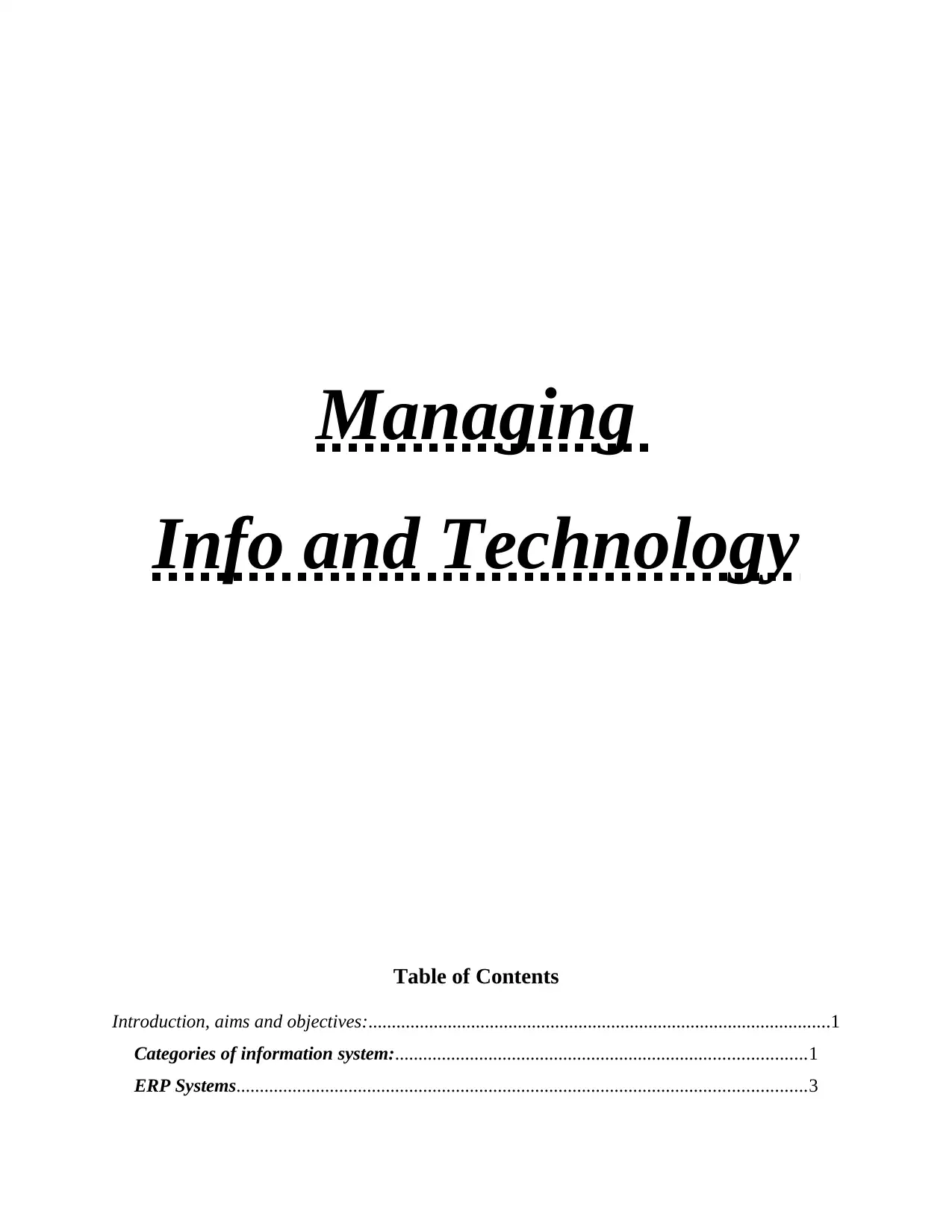
Managing
Info and Technology
Table of Contents
Introduction, aims and objectives:...................................................................................................1
Categories of information system:........................................................................................1
ERP Systems..........................................................................................................................3
Info and Technology
Table of Contents
Introduction, aims and objectives:...................................................................................................1
Categories of information system:........................................................................................1
ERP Systems..........................................................................................................................3
Paraphrase This Document
Need a fresh take? Get an instant paraphrase of this document with our AI Paraphraser
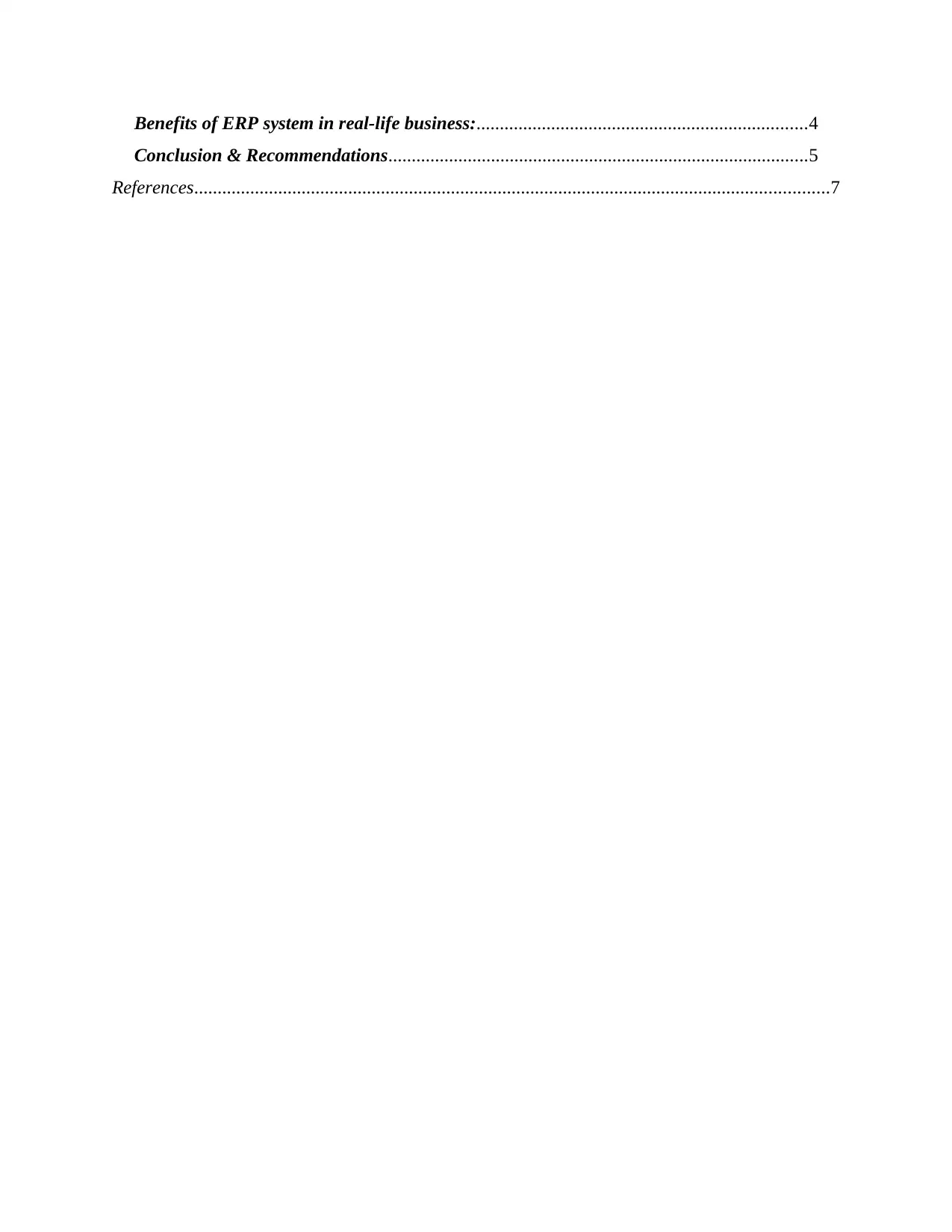
Benefits of ERP system in real-life business:.......................................................................4
Conclusion & Recommendations..........................................................................................5
References........................................................................................................................................7
Conclusion & Recommendations..........................................................................................5
References........................................................................................................................................7

⊘ This is a preview!⊘
Do you want full access?
Subscribe today to unlock all pages.

Trusted by 1+ million students worldwide
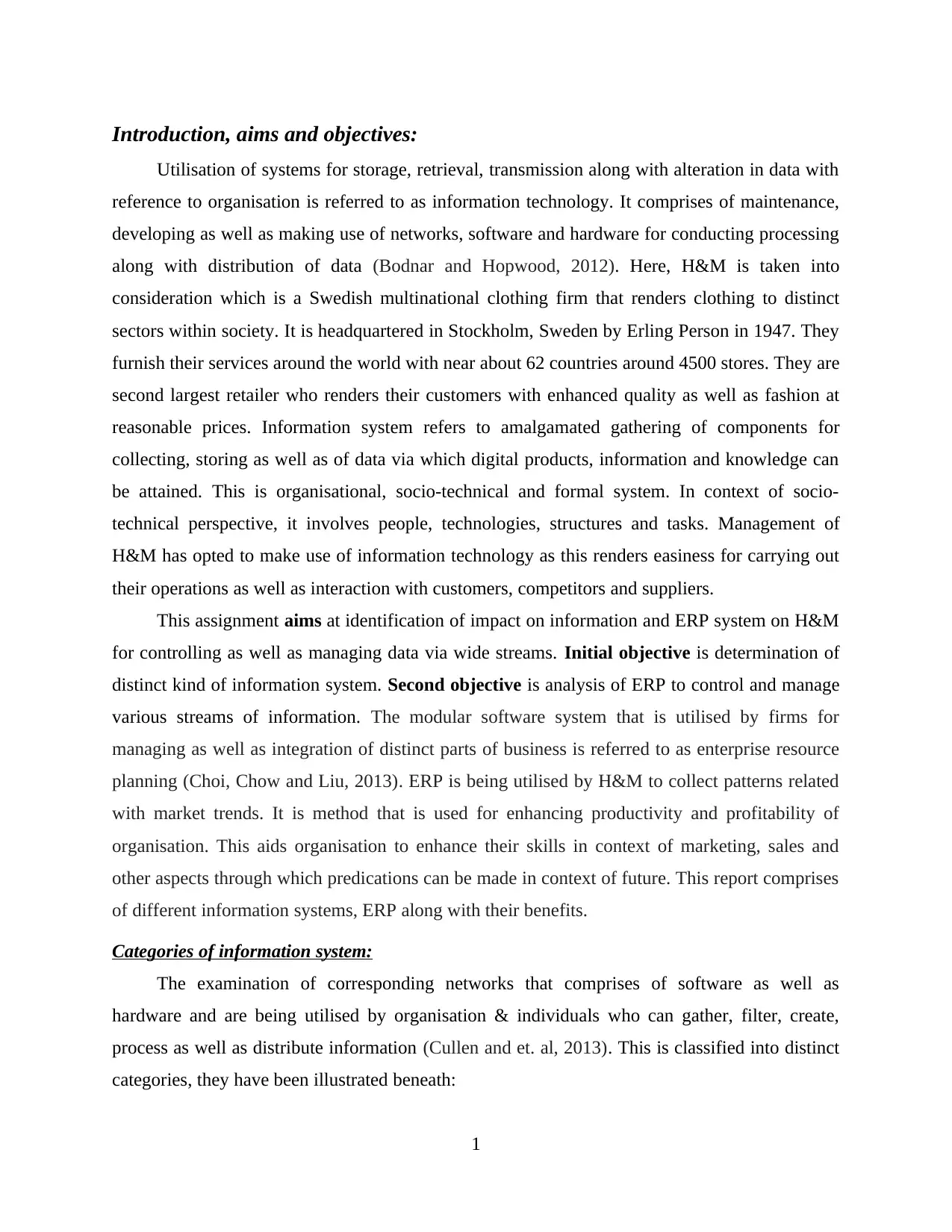
Introduction, aims and objectives:
Utilisation of systems for storage, retrieval, transmission along with alteration in data with
reference to organisation is referred to as information technology. It comprises of maintenance,
developing as well as making use of networks, software and hardware for conducting processing
along with distribution of data (Bodnar and Hopwood, 2012). Here, H&M is taken into
consideration which is a Swedish multinational clothing firm that renders clothing to distinct
sectors within society. It is headquartered in Stockholm, Sweden by Erling Person in 1947. They
furnish their services around the world with near about 62 countries around 4500 stores. They are
second largest retailer who renders their customers with enhanced quality as well as fashion at
reasonable prices. Information system refers to amalgamated gathering of components for
collecting, storing as well as of data via which digital products, information and knowledge can
be attained. This is organisational, socio-technical and formal system. In context of socio-
technical perspective, it involves people, technologies, structures and tasks. Management of
H&M has opted to make use of information technology as this renders easiness for carrying out
their operations as well as interaction with customers, competitors and suppliers.
This assignment aims at identification of impact on information and ERP system on H&M
for controlling as well as managing data via wide streams. Initial objective is determination of
distinct kind of information system. Second objective is analysis of ERP to control and manage
various streams of information. The modular software system that is utilised by firms for
managing as well as integration of distinct parts of business is referred to as enterprise resource
planning (Choi, Chow and Liu, 2013). ERP is being utilised by H&M to collect patterns related
with market trends. It is method that is used for enhancing productivity and profitability of
organisation. This aids organisation to enhance their skills in context of marketing, sales and
other aspects through which predications can be made in context of future. This report comprises
of different information systems, ERP along with their benefits.
Categories of information system:
The examination of corresponding networks that comprises of software as well as
hardware and are being utilised by organisation & individuals who can gather, filter, create,
process as well as distribute information (Cullen and et. al, 2013). This is classified into distinct
categories, they have been illustrated beneath:
1
Utilisation of systems for storage, retrieval, transmission along with alteration in data with
reference to organisation is referred to as information technology. It comprises of maintenance,
developing as well as making use of networks, software and hardware for conducting processing
along with distribution of data (Bodnar and Hopwood, 2012). Here, H&M is taken into
consideration which is a Swedish multinational clothing firm that renders clothing to distinct
sectors within society. It is headquartered in Stockholm, Sweden by Erling Person in 1947. They
furnish their services around the world with near about 62 countries around 4500 stores. They are
second largest retailer who renders their customers with enhanced quality as well as fashion at
reasonable prices. Information system refers to amalgamated gathering of components for
collecting, storing as well as of data via which digital products, information and knowledge can
be attained. This is organisational, socio-technical and formal system. In context of socio-
technical perspective, it involves people, technologies, structures and tasks. Management of
H&M has opted to make use of information technology as this renders easiness for carrying out
their operations as well as interaction with customers, competitors and suppliers.
This assignment aims at identification of impact on information and ERP system on H&M
for controlling as well as managing data via wide streams. Initial objective is determination of
distinct kind of information system. Second objective is analysis of ERP to control and manage
various streams of information. The modular software system that is utilised by firms for
managing as well as integration of distinct parts of business is referred to as enterprise resource
planning (Choi, Chow and Liu, 2013). ERP is being utilised by H&M to collect patterns related
with market trends. It is method that is used for enhancing productivity and profitability of
organisation. This aids organisation to enhance their skills in context of marketing, sales and
other aspects through which predications can be made in context of future. This report comprises
of different information systems, ERP along with their benefits.
Categories of information system:
The examination of corresponding networks that comprises of software as well as
hardware and are being utilised by organisation & individuals who can gather, filter, create,
process as well as distribute information (Cullen and et. al, 2013). This is classified into distinct
categories, they have been illustrated beneath:
1
Paraphrase This Document
Need a fresh take? Get an instant paraphrase of this document with our AI Paraphraser
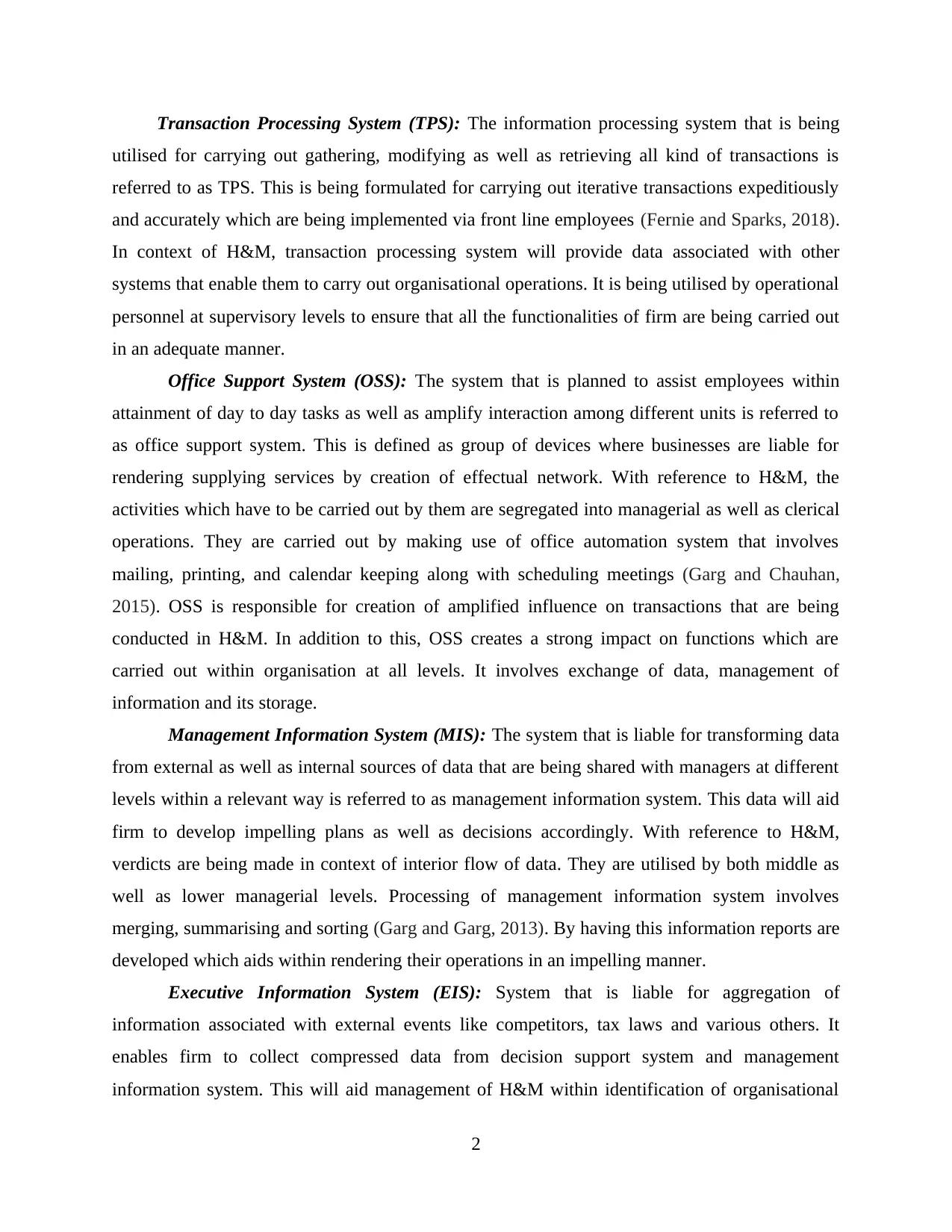
Transaction Processing System (TPS): The information processing system that is being
utilised for carrying out gathering, modifying as well as retrieving all kind of transactions is
referred to as TPS. This is being formulated for carrying out iterative transactions expeditiously
and accurately which are being implemented via front line employees (Fernie and Sparks, 2018).
In context of H&M, transaction processing system will provide data associated with other
systems that enable them to carry out organisational operations. It is being utilised by operational
personnel at supervisory levels to ensure that all the functionalities of firm are being carried out
in an adequate manner.
Office Support System (OSS): The system that is planned to assist employees within
attainment of day to day tasks as well as amplify interaction among different units is referred to
as office support system. This is defined as group of devices where businesses are liable for
rendering supplying services by creation of effectual network. With reference to H&M, the
activities which have to be carried out by them are segregated into managerial as well as clerical
operations. They are carried out by making use of office automation system that involves
mailing, printing, and calendar keeping along with scheduling meetings (Garg and Chauhan,
2015). OSS is responsible for creation of amplified influence on transactions that are being
conducted in H&M. In addition to this, OSS creates a strong impact on functions which are
carried out within organisation at all levels. It involves exchange of data, management of
information and its storage.
Management Information System (MIS): The system that is liable for transforming data
from external as well as internal sources of data that are being shared with managers at different
levels within a relevant way is referred to as management information system. This data will aid
firm to develop impelling plans as well as decisions accordingly. With reference to H&M,
verdicts are being made in context of interior flow of data. They are utilised by both middle as
well as lower managerial levels. Processing of management information system involves
merging, summarising and sorting (Garg and Garg, 2013). By having this information reports are
developed which aids within rendering their operations in an impelling manner.
Executive Information System (EIS): System that is liable for aggregation of
information associated with external events like competitors, tax laws and various others. It
enables firm to collect compressed data from decision support system and management
information system. This will aid management of H&M within identification of organisational
2
utilised for carrying out gathering, modifying as well as retrieving all kind of transactions is
referred to as TPS. This is being formulated for carrying out iterative transactions expeditiously
and accurately which are being implemented via front line employees (Fernie and Sparks, 2018).
In context of H&M, transaction processing system will provide data associated with other
systems that enable them to carry out organisational operations. It is being utilised by operational
personnel at supervisory levels to ensure that all the functionalities of firm are being carried out
in an adequate manner.
Office Support System (OSS): The system that is planned to assist employees within
attainment of day to day tasks as well as amplify interaction among different units is referred to
as office support system. This is defined as group of devices where businesses are liable for
rendering supplying services by creation of effectual network. With reference to H&M, the
activities which have to be carried out by them are segregated into managerial as well as clerical
operations. They are carried out by making use of office automation system that involves
mailing, printing, and calendar keeping along with scheduling meetings (Garg and Chauhan,
2015). OSS is responsible for creation of amplified influence on transactions that are being
conducted in H&M. In addition to this, OSS creates a strong impact on functions which are
carried out within organisation at all levels. It involves exchange of data, management of
information and its storage.
Management Information System (MIS): The system that is liable for transforming data
from external as well as internal sources of data that are being shared with managers at different
levels within a relevant way is referred to as management information system. This data will aid
firm to develop impelling plans as well as decisions accordingly. With reference to H&M,
verdicts are being made in context of interior flow of data. They are utilised by both middle as
well as lower managerial levels. Processing of management information system involves
merging, summarising and sorting (Garg and Garg, 2013). By having this information reports are
developed which aids within rendering their operations in an impelling manner.
Executive Information System (EIS): System that is liable for aggregation of
information associated with external events like competitors, tax laws and various others. It
enables firm to collect compressed data from decision support system and management
information system. This will aid management of H&M within identification of organisational
2
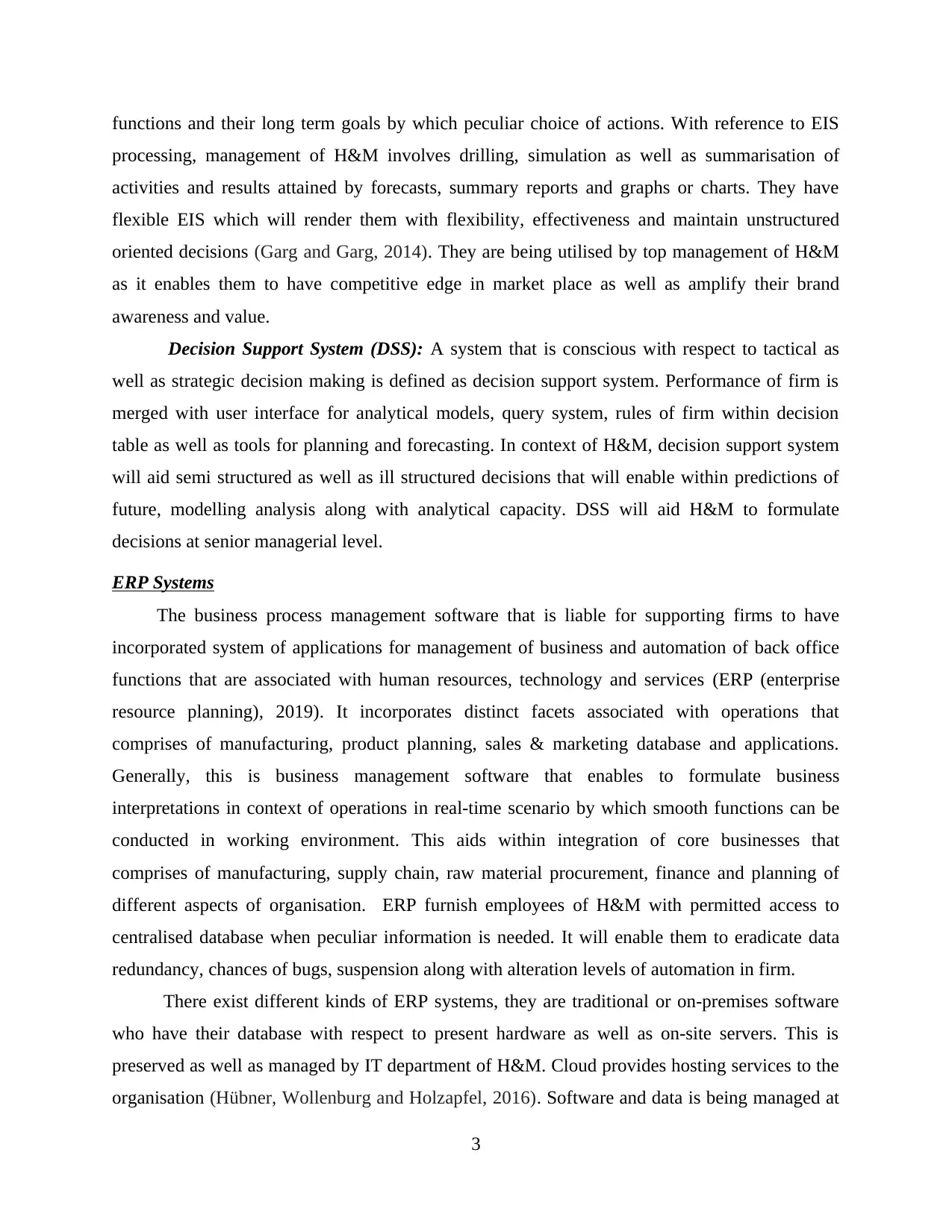
functions and their long term goals by which peculiar choice of actions. With reference to EIS
processing, management of H&M involves drilling, simulation as well as summarisation of
activities and results attained by forecasts, summary reports and graphs or charts. They have
flexible EIS which will render them with flexibility, effectiveness and maintain unstructured
oriented decisions (Garg and Garg, 2014). They are being utilised by top management of H&M
as it enables them to have competitive edge in market place as well as amplify their brand
awareness and value.
Decision Support System (DSS): A system that is conscious with respect to tactical as
well as strategic decision making is defined as decision support system. Performance of firm is
merged with user interface for analytical models, query system, rules of firm within decision
table as well as tools for planning and forecasting. In context of H&M, decision support system
will aid semi structured as well as ill structured decisions that will enable within predictions of
future, modelling analysis along with analytical capacity. DSS will aid H&M to formulate
decisions at senior managerial level.
ERP Systems
The business process management software that is liable for supporting firms to have
incorporated system of applications for management of business and automation of back office
functions that are associated with human resources, technology and services (ERP (enterprise
resource planning), 2019). It incorporates distinct facets associated with operations that
comprises of manufacturing, product planning, sales & marketing database and applications.
Generally, this is business management software that enables to formulate business
interpretations in context of operations in real-time scenario by which smooth functions can be
conducted in working environment. This aids within integration of core businesses that
comprises of manufacturing, supply chain, raw material procurement, finance and planning of
different aspects of organisation. ERP furnish employees of H&M with permitted access to
centralised database when peculiar information is needed. It will enable them to eradicate data
redundancy, chances of bugs, suspension along with alteration levels of automation in firm.
There exist different kinds of ERP systems, they are traditional or on-premises software
who have their database with respect to present hardware as well as on-site servers. This is
preserved as well as managed by IT department of H&M. Cloud provides hosting services to the
organisation (Hübner, Wollenburg and Holzapfel, 2016). Software and data is being managed at
3
processing, management of H&M involves drilling, simulation as well as summarisation of
activities and results attained by forecasts, summary reports and graphs or charts. They have
flexible EIS which will render them with flexibility, effectiveness and maintain unstructured
oriented decisions (Garg and Garg, 2014). They are being utilised by top management of H&M
as it enables them to have competitive edge in market place as well as amplify their brand
awareness and value.
Decision Support System (DSS): A system that is conscious with respect to tactical as
well as strategic decision making is defined as decision support system. Performance of firm is
merged with user interface for analytical models, query system, rules of firm within decision
table as well as tools for planning and forecasting. In context of H&M, decision support system
will aid semi structured as well as ill structured decisions that will enable within predictions of
future, modelling analysis along with analytical capacity. DSS will aid H&M to formulate
decisions at senior managerial level.
ERP Systems
The business process management software that is liable for supporting firms to have
incorporated system of applications for management of business and automation of back office
functions that are associated with human resources, technology and services (ERP (enterprise
resource planning), 2019). It incorporates distinct facets associated with operations that
comprises of manufacturing, product planning, sales & marketing database and applications.
Generally, this is business management software that enables to formulate business
interpretations in context of operations in real-time scenario by which smooth functions can be
conducted in working environment. This aids within integration of core businesses that
comprises of manufacturing, supply chain, raw material procurement, finance and planning of
different aspects of organisation. ERP furnish employees of H&M with permitted access to
centralised database when peculiar information is needed. It will enable them to eradicate data
redundancy, chances of bugs, suspension along with alteration levels of automation in firm.
There exist different kinds of ERP systems, they are traditional or on-premises software
who have their database with respect to present hardware as well as on-site servers. This is
preserved as well as managed by IT department of H&M. Cloud provides hosting services to the
organisation (Hübner, Wollenburg and Holzapfel, 2016). Software and data is being managed at
3
⊘ This is a preview!⊘
Do you want full access?
Subscribe today to unlock all pages.

Trusted by 1+ million students worldwide
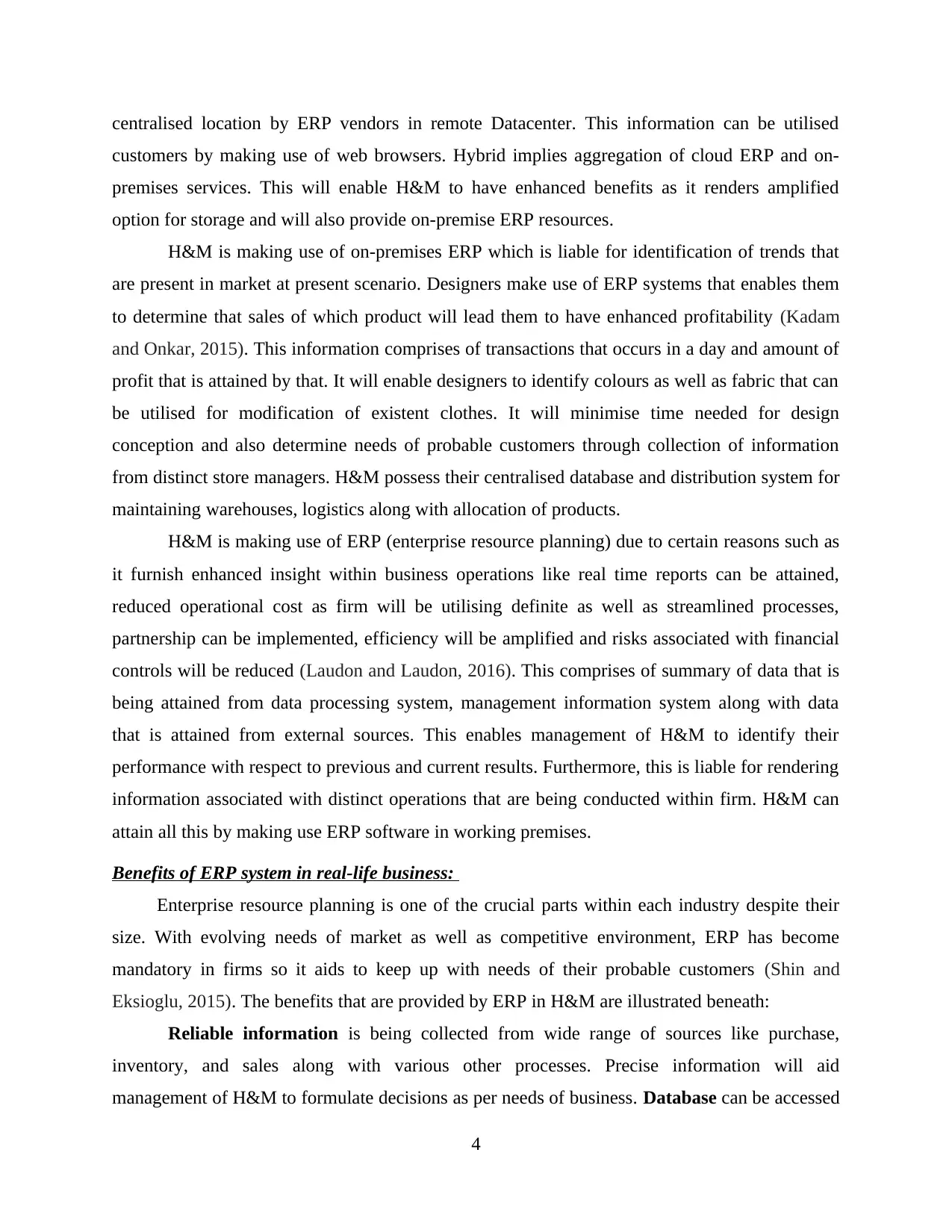
centralised location by ERP vendors in remote Datacenter. This information can be utilised
customers by making use of web browsers. Hybrid implies aggregation of cloud ERP and on-
premises services. This will enable H&M to have enhanced benefits as it renders amplified
option for storage and will also provide on-premise ERP resources.
H&M is making use of on-premises ERP which is liable for identification of trends that
are present in market at present scenario. Designers make use of ERP systems that enables them
to determine that sales of which product will lead them to have enhanced profitability (Kadam
and Onkar, 2015). This information comprises of transactions that occurs in a day and amount of
profit that is attained by that. It will enable designers to identify colours as well as fabric that can
be utilised for modification of existent clothes. It will minimise time needed for design
conception and also determine needs of probable customers through collection of information
from distinct store managers. H&M possess their centralised database and distribution system for
maintaining warehouses, logistics along with allocation of products.
H&M is making use of ERP (enterprise resource planning) due to certain reasons such as
it furnish enhanced insight within business operations like real time reports can be attained,
reduced operational cost as firm will be utilising definite as well as streamlined processes,
partnership can be implemented, efficiency will be amplified and risks associated with financial
controls will be reduced (Laudon and Laudon, 2016). This comprises of summary of data that is
being attained from data processing system, management information system along with data
that is attained from external sources. This enables management of H&M to identify their
performance with respect to previous and current results. Furthermore, this is liable for rendering
information associated with distinct operations that are being conducted within firm. H&M can
attain all this by making use ERP software in working premises.
Benefits of ERP system in real-life business:
Enterprise resource planning is one of the crucial parts within each industry despite their
size. With evolving needs of market as well as competitive environment, ERP has become
mandatory in firms so it aids to keep up with needs of their probable customers (Shin and
Eksioglu, 2015). The benefits that are provided by ERP in H&M are illustrated beneath:
Reliable information is being collected from wide range of sources like purchase,
inventory, and sales along with various other processes. Precise information will aid
management of H&M to formulate decisions as per needs of business. Database can be accessed
4
customers by making use of web browsers. Hybrid implies aggregation of cloud ERP and on-
premises services. This will enable H&M to have enhanced benefits as it renders amplified
option for storage and will also provide on-premise ERP resources.
H&M is making use of on-premises ERP which is liable for identification of trends that
are present in market at present scenario. Designers make use of ERP systems that enables them
to determine that sales of which product will lead them to have enhanced profitability (Kadam
and Onkar, 2015). This information comprises of transactions that occurs in a day and amount of
profit that is attained by that. It will enable designers to identify colours as well as fabric that can
be utilised for modification of existent clothes. It will minimise time needed for design
conception and also determine needs of probable customers through collection of information
from distinct store managers. H&M possess their centralised database and distribution system for
maintaining warehouses, logistics along with allocation of products.
H&M is making use of ERP (enterprise resource planning) due to certain reasons such as
it furnish enhanced insight within business operations like real time reports can be attained,
reduced operational cost as firm will be utilising definite as well as streamlined processes,
partnership can be implemented, efficiency will be amplified and risks associated with financial
controls will be reduced (Laudon and Laudon, 2016). This comprises of summary of data that is
being attained from data processing system, management information system along with data
that is attained from external sources. This enables management of H&M to identify their
performance with respect to previous and current results. Furthermore, this is liable for rendering
information associated with distinct operations that are being conducted within firm. H&M can
attain all this by making use ERP software in working premises.
Benefits of ERP system in real-life business:
Enterprise resource planning is one of the crucial parts within each industry despite their
size. With evolving needs of market as well as competitive environment, ERP has become
mandatory in firms so it aids to keep up with needs of their probable customers (Shin and
Eksioglu, 2015). The benefits that are provided by ERP in H&M are illustrated beneath:
Reliable information is being collected from wide range of sources like purchase,
inventory, and sales along with various other processes. Precise information will aid
management of H&M to formulate decisions as per needs of business. Database can be accessed
4
Paraphrase This Document
Need a fresh take? Get an instant paraphrase of this document with our AI Paraphraser
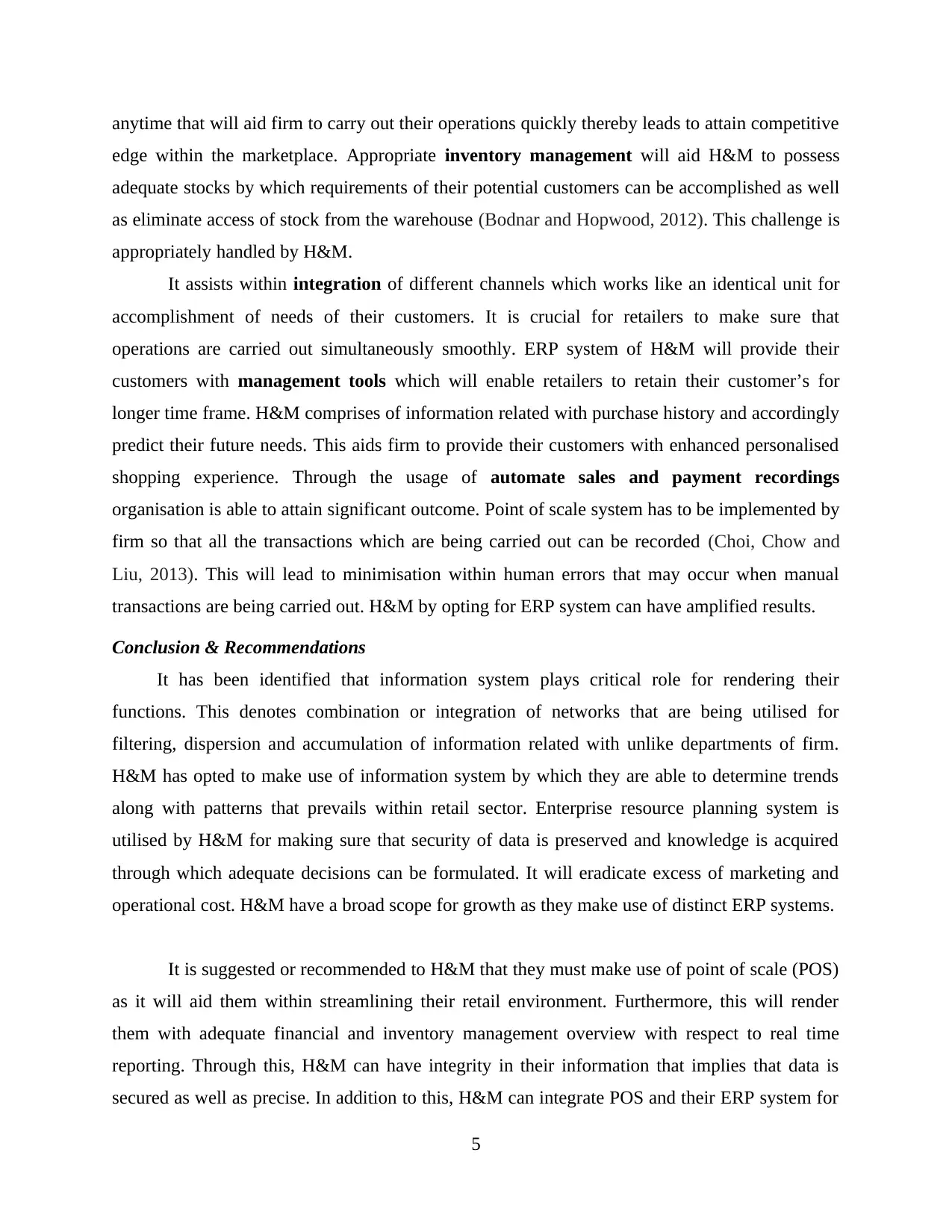
anytime that will aid firm to carry out their operations quickly thereby leads to attain competitive
edge within the marketplace. Appropriate inventory management will aid H&M to possess
adequate stocks by which requirements of their potential customers can be accomplished as well
as eliminate access of stock from the warehouse (Bodnar and Hopwood, 2012). This challenge is
appropriately handled by H&M.
It assists within integration of different channels which works like an identical unit for
accomplishment of needs of their customers. It is crucial for retailers to make sure that
operations are carried out simultaneously smoothly. ERP system of H&M will provide their
customers with management tools which will enable retailers to retain their customer’s for
longer time frame. H&M comprises of information related with purchase history and accordingly
predict their future needs. This aids firm to provide their customers with enhanced personalised
shopping experience. Through the usage of automate sales and payment recordings
organisation is able to attain significant outcome. Point of scale system has to be implemented by
firm so that all the transactions which are being carried out can be recorded (Choi, Chow and
Liu, 2013). This will lead to minimisation within human errors that may occur when manual
transactions are being carried out. H&M by opting for ERP system can have amplified results.
Conclusion & Recommendations
It has been identified that information system plays critical role for rendering their
functions. This denotes combination or integration of networks that are being utilised for
filtering, dispersion and accumulation of information related with unlike departments of firm.
H&M has opted to make use of information system by which they are able to determine trends
along with patterns that prevails within retail sector. Enterprise resource planning system is
utilised by H&M for making sure that security of data is preserved and knowledge is acquired
through which adequate decisions can be formulated. It will eradicate excess of marketing and
operational cost. H&M have a broad scope for growth as they make use of distinct ERP systems.
It is suggested or recommended to H&M that they must make use of point of scale (POS)
as it will aid them within streamlining their retail environment. Furthermore, this will render
them with adequate financial and inventory management overview with respect to real time
reporting. Through this, H&M can have integrity in their information that implies that data is
secured as well as precise. In addition to this, H&M can integrate POS and their ERP system for
5
edge within the marketplace. Appropriate inventory management will aid H&M to possess
adequate stocks by which requirements of their potential customers can be accomplished as well
as eliminate access of stock from the warehouse (Bodnar and Hopwood, 2012). This challenge is
appropriately handled by H&M.
It assists within integration of different channels which works like an identical unit for
accomplishment of needs of their customers. It is crucial for retailers to make sure that
operations are carried out simultaneously smoothly. ERP system of H&M will provide their
customers with management tools which will enable retailers to retain their customer’s for
longer time frame. H&M comprises of information related with purchase history and accordingly
predict their future needs. This aids firm to provide their customers with enhanced personalised
shopping experience. Through the usage of automate sales and payment recordings
organisation is able to attain significant outcome. Point of scale system has to be implemented by
firm so that all the transactions which are being carried out can be recorded (Choi, Chow and
Liu, 2013). This will lead to minimisation within human errors that may occur when manual
transactions are being carried out. H&M by opting for ERP system can have amplified results.
Conclusion & Recommendations
It has been identified that information system plays critical role for rendering their
functions. This denotes combination or integration of networks that are being utilised for
filtering, dispersion and accumulation of information related with unlike departments of firm.
H&M has opted to make use of information system by which they are able to determine trends
along with patterns that prevails within retail sector. Enterprise resource planning system is
utilised by H&M for making sure that security of data is preserved and knowledge is acquired
through which adequate decisions can be formulated. It will eradicate excess of marketing and
operational cost. H&M have a broad scope for growth as they make use of distinct ERP systems.
It is suggested or recommended to H&M that they must make use of point of scale (POS)
as it will aid them within streamlining their retail environment. Furthermore, this will render
them with adequate financial and inventory management overview with respect to real time
reporting. Through this, H&M can have integrity in their information that implies that data is
secured as well as precise. In addition to this, H&M can integrate POS and their ERP system for
5
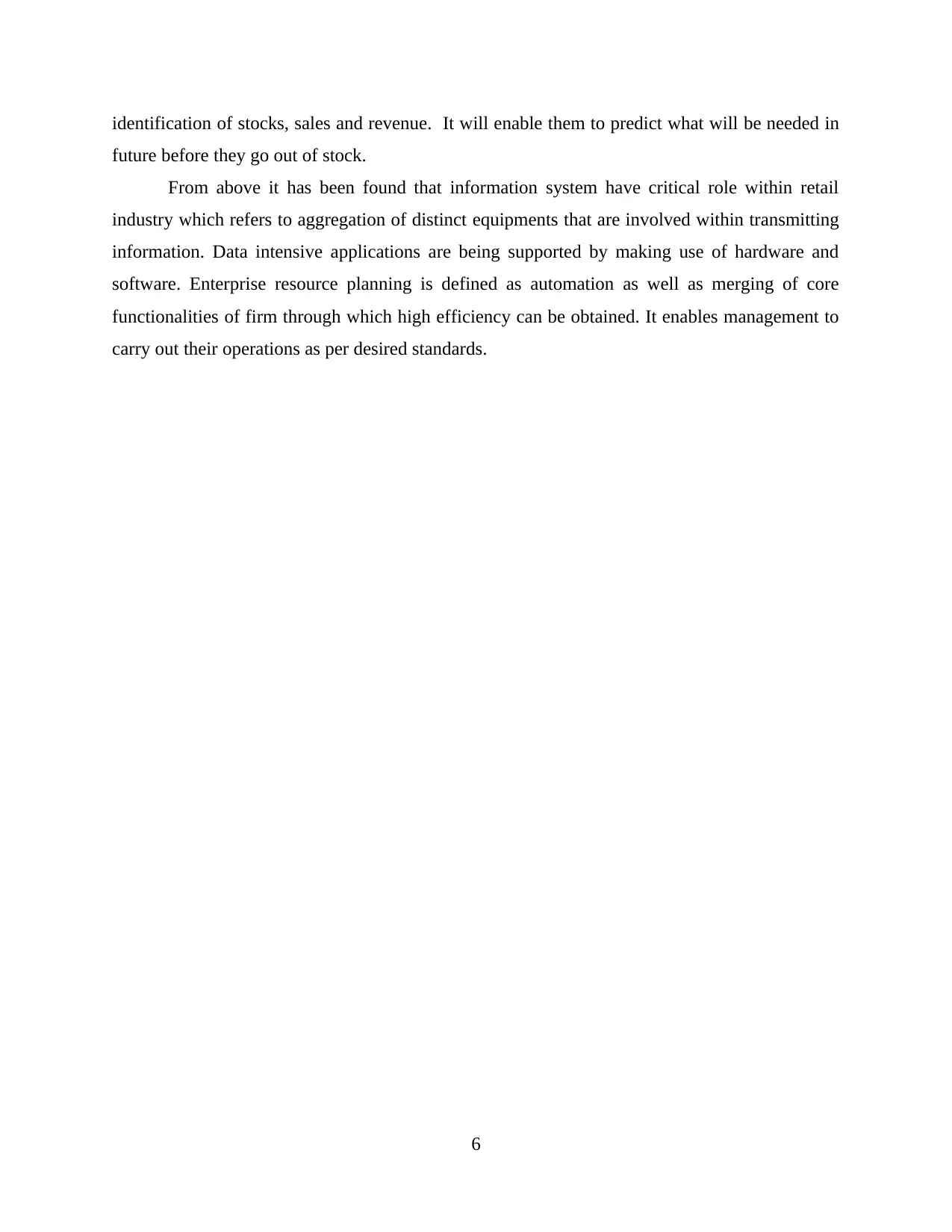
identification of stocks, sales and revenue. It will enable them to predict what will be needed in
future before they go out of stock.
From above it has been found that information system have critical role within retail
industry which refers to aggregation of distinct equipments that are involved within transmitting
information. Data intensive applications are being supported by making use of hardware and
software. Enterprise resource planning is defined as automation as well as merging of core
functionalities of firm through which high efficiency can be obtained. It enables management to
carry out their operations as per desired standards.
6
future before they go out of stock.
From above it has been found that information system have critical role within retail
industry which refers to aggregation of distinct equipments that are involved within transmitting
information. Data intensive applications are being supported by making use of hardware and
software. Enterprise resource planning is defined as automation as well as merging of core
functionalities of firm through which high efficiency can be obtained. It enables management to
carry out their operations as per desired standards.
6
⊘ This is a preview!⊘
Do you want full access?
Subscribe today to unlock all pages.

Trusted by 1+ million students worldwide
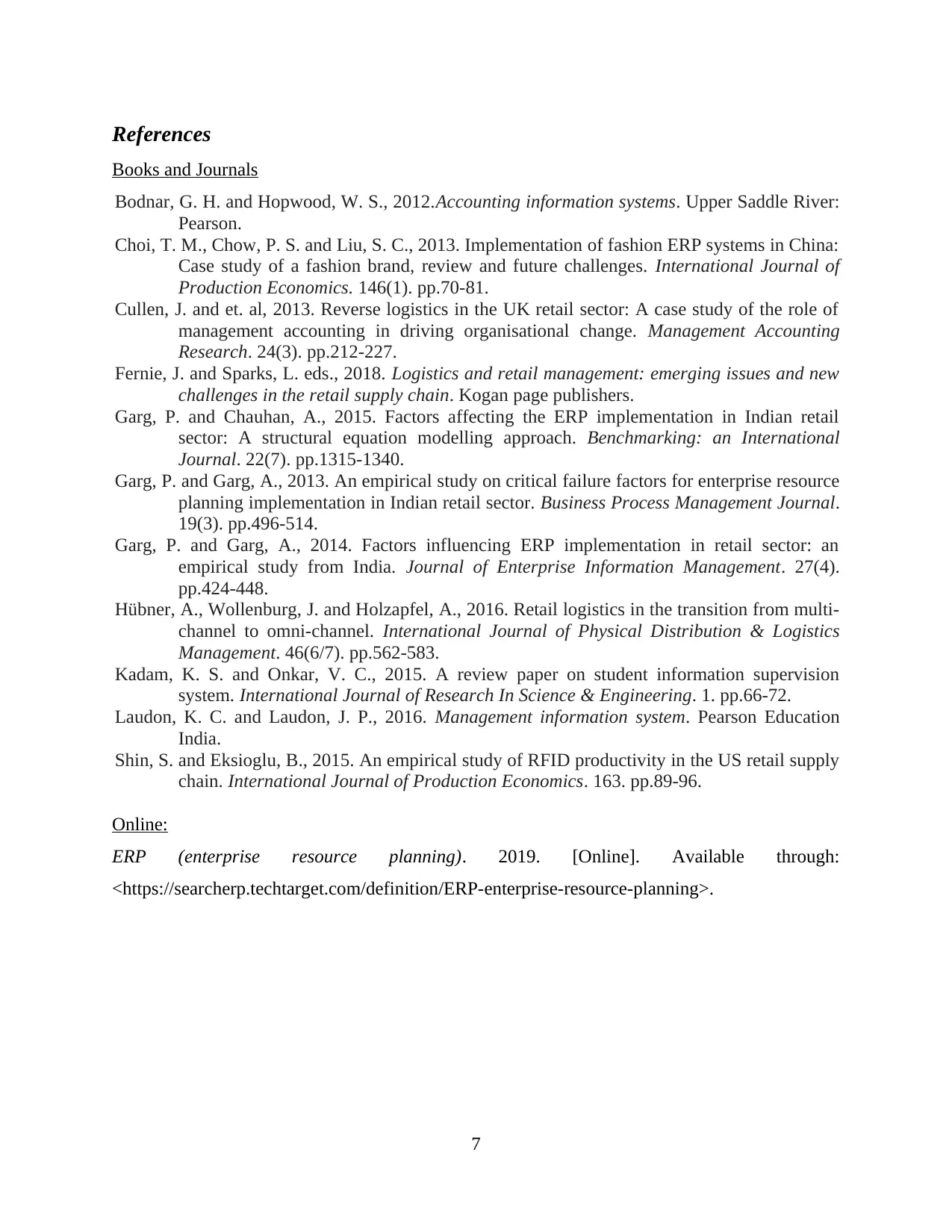
References
Books and Journals
Bodnar, G. H. and Hopwood, W. S., 2012.Accounting information systems. Upper Saddle River:
Pearson.
Choi, T. M., Chow, P. S. and Liu, S. C., 2013. Implementation of fashion ERP systems in China:
Case study of a fashion brand, review and future challenges. International Journal of
Production Economics. 146(1). pp.70-81.
Cullen, J. and et. al, 2013. Reverse logistics in the UK retail sector: A case study of the role of
management accounting in driving organisational change. Management Accounting
Research. 24(3). pp.212-227.
Fernie, J. and Sparks, L. eds., 2018. Logistics and retail management: emerging issues and new
challenges in the retail supply chain. Kogan page publishers.
Garg, P. and Chauhan, A., 2015. Factors affecting the ERP implementation in Indian retail
sector: A structural equation modelling approach. Benchmarking: an International
Journal. 22(7). pp.1315-1340.
Garg, P. and Garg, A., 2013. An empirical study on critical failure factors for enterprise resource
planning implementation in Indian retail sector. Business Process Management Journal.
19(3). pp.496-514.
Garg, P. and Garg, A., 2014. Factors influencing ERP implementation in retail sector: an
empirical study from India. Journal of Enterprise Information Management. 27(4).
pp.424-448.
Hübner, A., Wollenburg, J. and Holzapfel, A., 2016. Retail logistics in the transition from multi-
channel to omni-channel. International Journal of Physical Distribution & Logistics
Management. 46(6/7). pp.562-583.
Kadam, K. S. and Onkar, V. C., 2015. A review paper on student information supervision
system. International Journal of Research In Science & Engineering. 1. pp.66-72.
Laudon, K. C. and Laudon, J. P., 2016. Management information system. Pearson Education
India.
Shin, S. and Eksioglu, B., 2015. An empirical study of RFID productivity in the US retail supply
chain. International Journal of Production Economics. 163. pp.89-96.
Online:
ERP (enterprise resource planning). 2019. [Online]. Available through:
<https://searcherp.techtarget.com/definition/ERP-enterprise-resource-planning>.
7
Books and Journals
Bodnar, G. H. and Hopwood, W. S., 2012.Accounting information systems. Upper Saddle River:
Pearson.
Choi, T. M., Chow, P. S. and Liu, S. C., 2013. Implementation of fashion ERP systems in China:
Case study of a fashion brand, review and future challenges. International Journal of
Production Economics. 146(1). pp.70-81.
Cullen, J. and et. al, 2013. Reverse logistics in the UK retail sector: A case study of the role of
management accounting in driving organisational change. Management Accounting
Research. 24(3). pp.212-227.
Fernie, J. and Sparks, L. eds., 2018. Logistics and retail management: emerging issues and new
challenges in the retail supply chain. Kogan page publishers.
Garg, P. and Chauhan, A., 2015. Factors affecting the ERP implementation in Indian retail
sector: A structural equation modelling approach. Benchmarking: an International
Journal. 22(7). pp.1315-1340.
Garg, P. and Garg, A., 2013. An empirical study on critical failure factors for enterprise resource
planning implementation in Indian retail sector. Business Process Management Journal.
19(3). pp.496-514.
Garg, P. and Garg, A., 2014. Factors influencing ERP implementation in retail sector: an
empirical study from India. Journal of Enterprise Information Management. 27(4).
pp.424-448.
Hübner, A., Wollenburg, J. and Holzapfel, A., 2016. Retail logistics in the transition from multi-
channel to omni-channel. International Journal of Physical Distribution & Logistics
Management. 46(6/7). pp.562-583.
Kadam, K. S. and Onkar, V. C., 2015. A review paper on student information supervision
system. International Journal of Research In Science & Engineering. 1. pp.66-72.
Laudon, K. C. and Laudon, J. P., 2016. Management information system. Pearson Education
India.
Shin, S. and Eksioglu, B., 2015. An empirical study of RFID productivity in the US retail supply
chain. International Journal of Production Economics. 163. pp.89-96.
Online:
ERP (enterprise resource planning). 2019. [Online]. Available through:
<https://searcherp.techtarget.com/definition/ERP-enterprise-resource-planning>.
7
1 out of 10
Related Documents
Your All-in-One AI-Powered Toolkit for Academic Success.
+13062052269
info@desklib.com
Available 24*7 on WhatsApp / Email
![[object Object]](/_next/static/media/star-bottom.7253800d.svg)
Unlock your academic potential
Copyright © 2020–2025 A2Z Services. All Rights Reserved. Developed and managed by ZUCOL.





